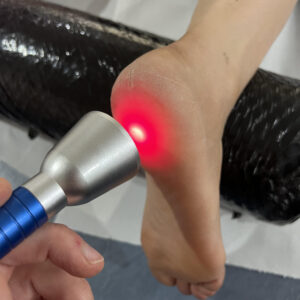Find Local High-Intensity Laser Therapy
High-intensity laser therapy (HILT) is a non-invasive medical therapy that uses laser light to promote healing and relieve pain. Unlike other types of laser treatment, HILT employs a more powerful laser to give a focused dosage of energy to the afflicted region. This enables deeper tissue penetration, resulting in better pain alleviation and faster recovery.
HILT varies from LLLT in terms of power output and treatment depth. LLLT is a low-power laser commonly used to treat superficial ailments, including wound healing and skin rejuvenation. On the other hand, HILT may go deeper into the tissues and is frequently used to treat musculoskeletal problems like back pain, knee pain, and arthritis.
Key Takeaways
- High-Intensity Laser Therapy is a non-invasive treatment that uses laser light to promote healing and reduce pain.
- Laser light therapy stimulates cellular activity and increases blood flow to the affected area.
- Benefits of laser pain therapy include reduced inflammation, improved range of motion, and faster healing times.
- Laser therapy can benefit a wide range of individuals, including athletes, seniors, and those with chronic pain conditions.
- Conditions that can be treated with laser therapy include back pain, knee pain, arthritis, and sports injuries.
 How Does Laser Light Therapy Work?
How Does Laser Light Therapy Work?
Laser light treatment stimulates the body’s natural healing mechanisms at the cellular level. When cells absorb laser light, metabolic processes quicken tissue healing and lessen inflammation.
The laser light interacts with mitochondria, the cell’s powerhouses. This connection encourages the synthesis of ATP, the cell’s energy currency. Increased ATP synthesis boosts cellular metabolism and improves tissue healing.
Laser light treatment produces ATP and enhances blood flow to the treated region. This helps to provide oxygen and nutrients to cells while eliminating waste products and contaminants. Increased blood flow also reduces inflammation and oedema, aiding in pain alleviation.
Benefits of Laser Pain Therapy
Laser treatment has various benefits for pain reduction. One of the primary advantages is its ability to minimise inflammation. Inflammation is a normal reaction to injury or illness but can cause pain and tissue damage when it persists.
Laser treatment reduces inflammation by boosting blood flow and triggering the production of anti-inflammatory chemicals. Another advantage of laser treatment is its ability to facilitate healing. Laser treatment speeds up the repair process by boosting cellular metabolism and ATP synthesis, assisting in regenerating injured tissues.
This is especially advantageous for those with chronic diseases like arthritis or tendonitis. Laser treatment also relieves pain by inhibiting pain signals and increasing the release of endorphins, the body’s natural painkillers. This can help lessen the need for pain medication while improving the overall quality of life.
Who Can Benefit from Laser Therapy?
Athletes with sports injuries and the elderly with chronic pain are just two of the many patient populations that can benefit from laser therapy. Use it alone or combine it with other treatments like chiropractic or physical therapy for the best results.
Conditions affecting the muscles and joints, such as arthritis, back pain, knee pain, and neck pain, may be amenable to laser treatment. Injuries to the soft tissues, like tendinitis, sprains, and strains, can also be treated with this.
Children and older people can benefit from laser therapy since it is safe and effective. This alternative is excellent for people who want a more natural way to manage their pain because it is non-invasive and doesn’t need surgery or drugs.
Conditions Treated with Laser Therapy
A variety of acute and chronic illnesses can be effectively treated using laser therapy. Laser therapy is effective in treating a variety of medical issues, including:
- For those suffering from persistent back pain, laser therapy may effectively reduce inflammation and speed the healing process in the affected muscles and tissues.
- Knee pain: Laser therapy can treat osteoarthritis, tendinitis, and ligament injuries that cause knee pain.
- Laser therapy can alleviate inflammation and pain caused by arthritis, improving the function and mobility of affected joints.
- Ailments sustained while playing sports: Laser therapy can help athletes heal more quickly and return to their games for typical sports ailments like sprains, strains, and tendinitis.
- Herniated discs and muscular strains are common causes of chronic neck discomfort, but laser therapy can help.
- For plantar fasciitis, a laser treatment can alleviate heel discomfort by reducing inflammation and speeding healing of the plantar fascia.
- Laser therapy can alleviate inflammation and pain in carpal tunnel syndrome, improve hand function, and decrease the likelihood that surgery is necessary.
Laser Therapy for Back Pain: How it Works
Back discomfort is relatively prevalent and can significantly impact daily activities, making it a debilitating condition. Back pain sufferers may find comfort and a faster recovery with laser therapy.
If you’re experiencing back pain, a laser treatment session may be just what you need. The laser light travels deep into the tissues to stimulate cellular metabolism and ATP synthesis, helping to reduce inflammation and promote tissue repair.
Laser treatment for back pain has several advantages, such as decreased inflammation and pain, increased mobility, and a speedier recovery time. It is a safe and effective alternative to medication and surgery for people suffering from back pain, and it does not involve any intrusive procedures.
 Laser Therapy for Knee Pain: What to Expect
Laser Therapy for Knee Pain: What to Expect
Several conditions, such as ligament damage, tendinitis, or arthritis, can lead to knee pain. Laser therapy can decrease swelling and speed up the healing process in the injured tissues, alleviating knee discomfort.
When treating knee pain using laser therapy, the beam is focused directly on the knee joint. The laser light travels deep into the tissues to stimulate cellular metabolism and ATP synthesis, helping to reduce inflammation and promote tissue repair.
Patients may feel warm during therapy but shouldn’t be too uncomfortable. Treatment sessions usually last five to fifteen minutes, though this might vary greatly depending on the patient’s condition.
The best results might require more than one session; most patients require six to twelve sessions. The frequency of sessions depends on the severity of the condition and how well the patient responds to treatment.
Is laser therapy with high intensity safe?
High-intensity laser therapy has an excellent reputation for being safe and effective at healing damaged tissues and relieving pain. Patients who want a more natural approach to pain management may find this non-invasive treatment ideal, as it does not involve medication or surgery.
Since HILT is a medical treatment, it is not without its risks and adverse effects. Common but minor side effects include injection site redness or swelling, little pain during or after the procedure, and transient worsening of symptoms.
Talk to a doctor before starting treatment to ensure HILT is a good fit for your condition. They can tailor their advice based on your condition and medical background.
 Finding a High-Intensity Laser Treatment Provider Near You
Finding a High-Intensity Laser Treatment Provider Near You
Choosing a trustworthy laser therapy provider in your area is critical if you are thinking about high-intensity laser therapy for your pain or injury. To locate a competent practitioner of high-intensity laser therapy, consider the following:
- One good place to start is by looking for local suppliers online. Find doctors with good reputations who focus on high-intensity laser treatment.
- Seek advice from others. Contact anybody you know who has had success with high-intensity laser treatment, whether a friend, relative, or medical expert. They could know someone reliable who can help them out.
- Evaluate credentials: Before committing to high-intensity laser therapy, make sure your practitioner has the proper licencing and certifications. They should possess the requisite training and expertise to provide safe and effective treatment.
- Make an appointment for a consultation to review your symptoms, diagnosis, and treatment choices with your healthcare practitioner before making a treatment commitment. Here, you can ask any queries and see whether they suit your requirements.
What to Expect During Your Laser Therapy Session
Seated or lying down in a comfortable position is what you can anticipate during a laser therapy session. The practitioner will carefully guide the laser beam to the injury site, treating each area individually.
You can feel warmth during the treatment, but it won’t hurt. Please inform the provider of any discomfort you may be experiencing so they can make the necessary adjustments.
The size of the treatment area and the severity of the condition determine how long the treatment session will last. Still, it usually ranges from 5 to 15 minutes. For the best outcomes, it may be necessary to schedule multiple sessions; typically, patients need between six and twelve sessions.
Your clinician may suggest avoiding vigorous activity or applying ice to the treated region as post-treatment care. Adhering to these instructions is crucial. It can speed up healing and help you get the most out of your treatment.
This article discusses the advantages of laser therapy for pain management. It may pique your interest if you seek out a local provider of high-intensity laser therapy. Arthritis, sports injuries, and chronic pain are just a few of the problems that high-intensity laser therapy can help alleviate. In addition to explaining the science behind it, it describes the benefits of this non-invasive therapy option. Find a clinic in your area and read more about high-intensity laser therapy by clicking here: High-Intensity Laser Therapy: A Powerful Solution for Pain Management.
FAQs
What is high-intensity laser treatment?
High-intensity laser therapy is a non-invasive medical treatment that uses a high-powered laser to stimulate healing and reduce pain in damaged tissues.
How does high-intensity laser therapy work?
High-intensity laser therapy delivers a concentrated beam of light energy to the affected area. This energy penetrates deep into the tissues, stimulating cellular activity and promoting healing.
What conditions can be treated with high-intensity laser therapy?
High-intensity laser therapy can be used to treat a wide range of conditions, including chronic pain, arthritis, sports injuries, and post-surgical pain.
Is high-intensity laser treatment safe?
Yes, high-intensity laser therapy is generally considered safe. However, it is essential to receive treatment from a qualified healthcare professional who has experience with this type of therapy.
What are the benefits of high-intensity laser treatment?
The benefits of high-intensity laser therapy include reduced pain and inflammation, improved circulation, and accelerated healing.
How long does a high-intensity laser treatment session last?
The length of a high-intensity laser therapy session can vary depending on the condition being treated and the severity of the symptoms. Typically, sessions last between 10 and 30 minutes.
How many high-intensity laser treatment sessions are needed?
The number of high-intensity laser therapy sessions needed can vary depending on the patient’s condition and the individual patient. Some patients may see improvement after just one session, while others may require multiple sessions over several weeks or months.
The Article High-Intensity Laser Therapy – Discover Therapists Near You appeared first on MCR Therapies.
The Article High-Intensity Laser Therapy – Discover Therapists Near You Was Found On https://limitsofstrategy.com

